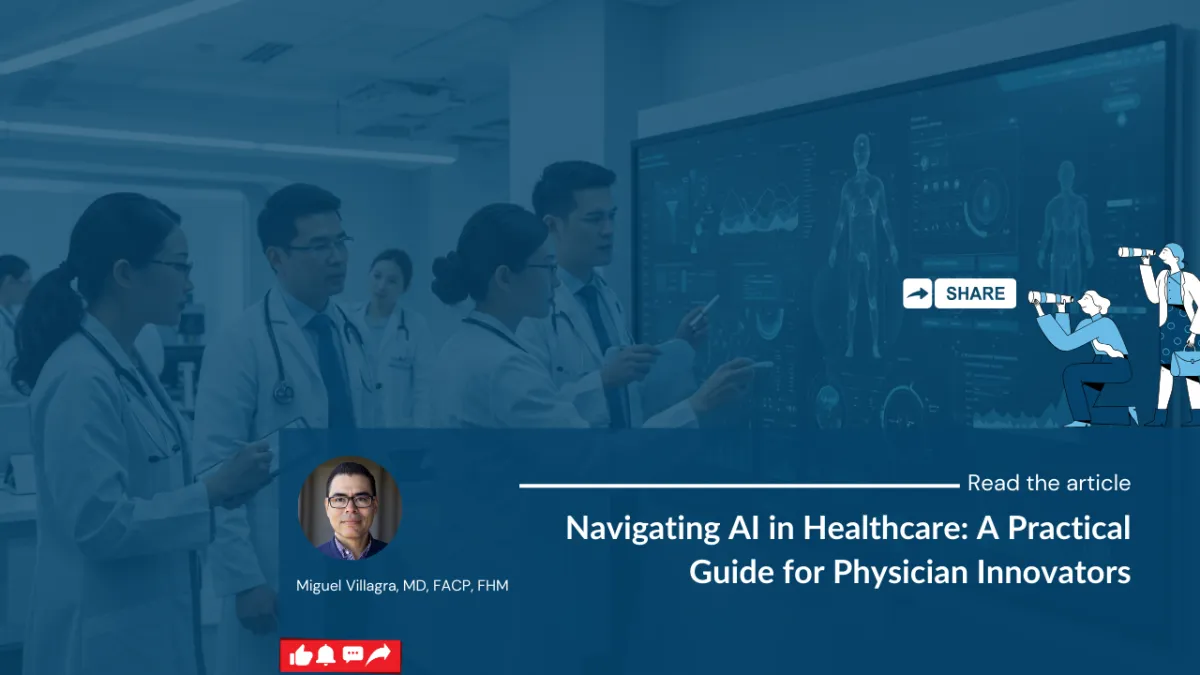
Navigating AI in Healthcare: A Practical Guide for Physician Innovators

AI is no longer optional—it’s becoming essential. For physicians navigating the demands of modern healthcare, artificial intelligence can be more than a buzzword. It’s a tool for restoring time, reducing burnout, and enhancing both patient care and professional fulfillment.
This guide is built for physician entrepreneurs, clinical leaders, and curious clinicians ready to explore AI—without needing a tech background. Let’s demystify AI and walk through how you can begin, one intentional step at a time.

Step 1: Understand What AI Really Is
Think of AI as a tool that mimics human reasoning—an assistant that can process information, generate responses, and even predict outcomes. You don’t need to master algorithms. Focus on core concepts:
What are Large Language Models (LLMs)?
How does prompt engineering improve responses?
Where does AI add value in clinical or operational workflows?
▶ Recommended Resource: AI for Everyone – Coursera (Andrew Ng)
Step 2: Align AI with Your Needs
Before diving into tools, ask:
What part of my day feels repetitive or energy-draining?
Which tasks slow me down but don’t require clinical judgment?
Whether it’s managing inboxes, summarizing research, or drafting patient notes—AI can become your co-pilot. Clarity leads to better adoption.
Step 3: Learn with Trusted Resources
Learning AI doesn’t need to be time-consuming. Here are great starting points:
LinkedIn Learning: Bite-sized, certificate-based AI fundamentals
Harvard’s HMX Pro: “AI in Healthcare” course tailored for clinicians
▶ Tip: Ask ChatGPT to summarize lengthy AI tutorials into key takeaways or quizzes!
Step 4: Learn by Doing (Not Just Watching)
Use the 1:5 rule—1 hour of theory, 5 hours of play. Practice prompt writing. Build a mini tool using GPTs. Try voice dictation with AI scribes.
💬 Example: “Summarize this 20-minute Grand Rounds recording” → let AI produce a readable executive summary.
Step 5: Let AI Be Your Summarization Assistant
AI excels at turning noise into clarity:
Turn CME PDFs into digestible bullets.
Generate clinical briefs for interdisciplinary meetings.
Convert Zoom transcripts into structured notes.
This saves hours—just remember to validate outputs before acting on them.
Step 6: Know the Boundaries—Privacy First
Any use of AI must comply with HIPAA and institutional standards. When using tools like AI scribes or documentation assistants:
Choose HIPAA-compliant platforms.
Avoid uploading identifiable data to general-use tools.
Inform patients transparently if AI is involved in their care.
▶ Compliant tools: Mariana AI, Doximity Answer, Quickblox
Step 7: Audit Your Workflow for Automation
Try this quick framework:
Ask Yourself…
AI Solution
“Where do I spend most time on admin?”
Smart summaries & note templates
“What tasks are repeatable?”
Auto-generated emails, follow-ups
“What requires judgment vs. documentation?”
Let AI prep, you review and approve
Step 8: Explore the Right Tools for You
Here are physician-recommended tools, categorized by function:
Tool
Purpose
ChatGPT
Brainstorming, Marketing, Writing
Perplexity AI
Source-backed search (ideal for research)
Gemini AI
Workflow support inside Google Docs, Gmail
Doximity Answer
Peer-powered clinical Q&A
AI Medical Scribes
Clinical documentation (Mariana)
AI Medical Agents
Advanced AI agents (Quickblox)
Step 9: Commit to Lifelong Learning
Subscribe to AI digests or clinical tech newsletters. Set a 30-minute “AI reflection hour” weekly. Share what you learn with peers. You don’t need to know everything—just be willing to stay curious.
▶ Newsletters to follow:
Step 10: Strengthen Human-AI Collaboration Skills
Here are the real differentiators in the AI era:
Clinical Judgment: AI can assist, but not diagnose or treat (yet).
Critical Thinking: Always double-check for bias or hallucination.
Data Interpretation: Understand what AI outputs mean clinically.
Adaptability: Stay flexible as tech evolves.

🚫 Debunking Common AI Myths
❌ “AI will replace doctors.”
✅ AI augments doctors. It handles the administrative overload so you can focus on care.
❌ “AI is too technical.”
✅ You don’t need to code. You just need curiosity and clear questions.
Final Thoughts: Start Small, Think Long-Term
AI doesn’t require perfection—it rewards progress. Begin with one tool. Test one workflow enhancement. Learn what works for you and your patients.
In the end, AI should be your assistant, not your replacement. Your judgment, empathy, and leadership remain irreplaceable.
Share Your Story: Connect with us on social media using the hashtag #Adoctorsjourney.
Facebook | LinkedIn | Instagram | YouTube | TikTok
Listen to the Full Episode
Subscribe to our newsletter
Want more tips, use cases, and updates on physician-friendly AI tools? Join our podcast andd newsletter. #Adoctorsjourney.
